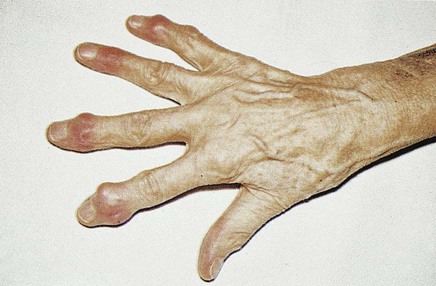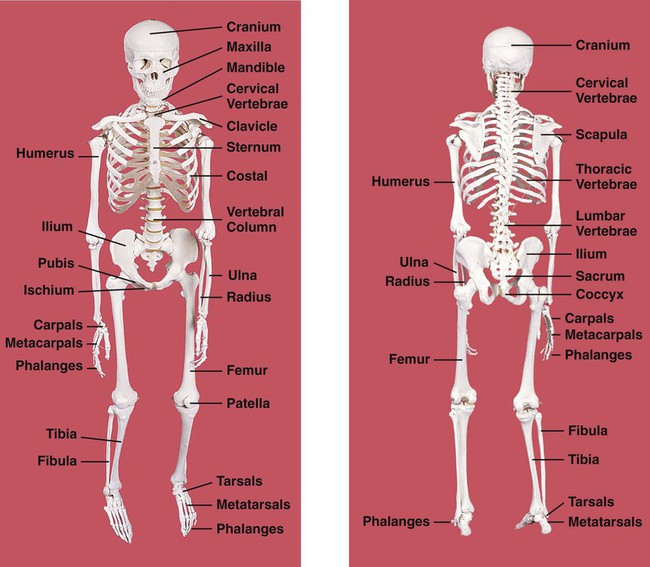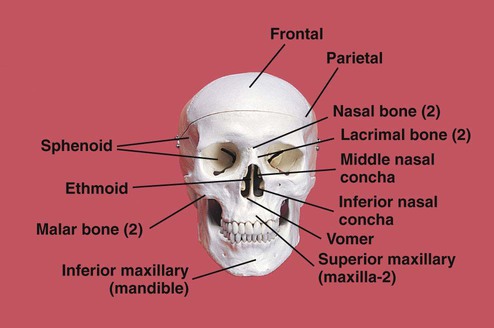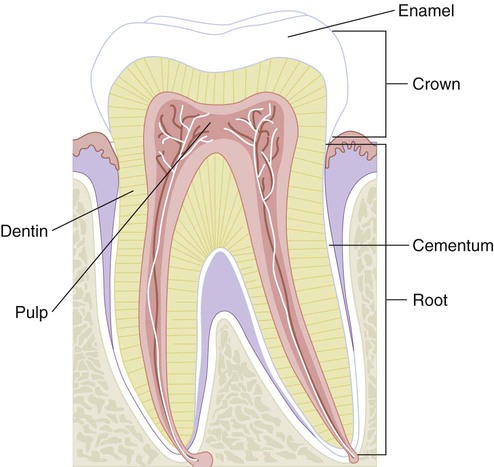Chapter 14 *A transition syllable or vowel may be added to or deleted from the word parts to make the combining form. The human body has more than 200 bones (Table 14-1). The skeletal system works directly with the muscular system to perform many functions, including the following: TABLE 14-1 Bones may have cartilage, a fibrous connective tissue, on some surfaces to prevent friction. Bones are attached to other bones by ligaments. A sheet of fibrous tissue connecting bone to bone is called an aponeurosis (ap-o-noo-RO-sis). Bones are joined to muscles by tendons. Fascia (FASH-ee-uh) is a variable fibrous connective tissue that joins organs. Chapter 15 provides more information about the muscular system. The two major types of bone tissue are dense (compact) and loosely packed or spongy (cancellous). The skeletal system consists of two major groups of bones (Fig. 14-1): Bones are also classified by shape (Table 14-2): TABLE 14-2 The skull includes the bones of the cranium, face, and ear. The cranium is made up of eight bones (Fig. 14-2). The sinus cavities make the skull lighter and the voice sound stronger. At birth, the bones of the cranium have two openings called fontanels. These close by 2 years of age. The face is made up of 13 bones (Fig. 14-3). The lower jaw (mandible) is the only movable bone of the skull. The adult has 32 teeth after the deciduous or primary teeth are replaced (Fig. 14-4). Each tooth has a number of parts (Fig. 14-5): The four major types of teeth have different shapes and functions (Table 14-3). TABLE 14-3
Skeletal System
 Define at least 10 terms relating to the skeletal system.
Define at least 10 terms relating to the skeletal system.
 Describe the five functions of the skeletal system.
Describe the five functions of the skeletal system.
 Identify at least 10 structures of the skeletal system.
Identify at least 10 structures of the skeletal system.
 Identify at least three methods of assessment of the skeletal system.
Identify at least three methods of assessment of the skeletal system.
Term
Definition
Prefix
Root
Suffix
Arthritis
Inflammation of the joint
arthr
itis
Arthrodesis
Surgical union or fixation of the joint
arthr/o
desis
Arthroplasty
Plastic reconstruction of the joint
arthr/o
plasty
Cervical
Pertaining to the neck
cervic
al
Chondrectomy
Removal of the cartilage
chondr
ectomy
Intercostal
Between the ribs
inter
cost
al
Odontology
Study of the tooth
odont
ology
Orthopedics
Pertaining to correcting or straightening the bones
ortho
ped
ics
Osteoarthritis
Inflammation of the bones and joints
osteo
arthr
itis
Periodontal
Around the tooth
peri/o
dont
al
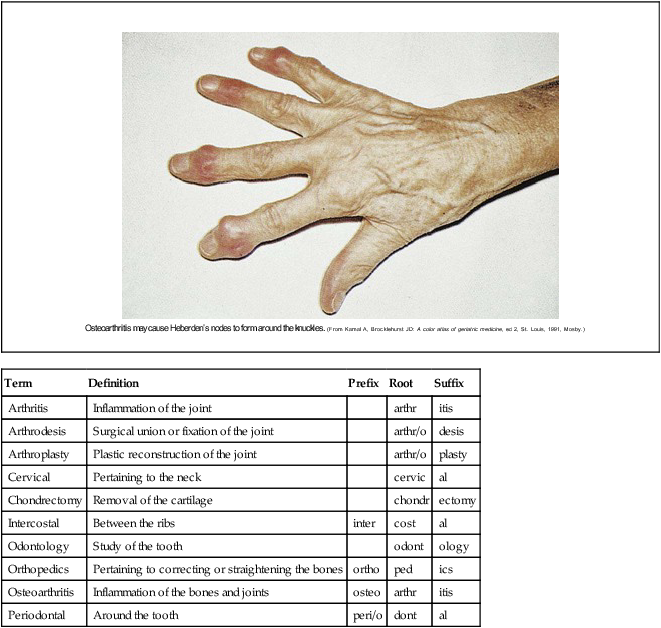
Structure and Function of the Skeletal System
Part of Skeleton
Body Part
Body Part Division
Names of Bones
Axial skeleton
Skull (28)
Cranium (8)
Frontal (1), parietal (2), temporal (2), occipital (1), sphenoid (1), ethmoid (1)
Face (14)
Nasal (2), maxillary (2), zygomatic (2), mandible (1), lacrimal (2), palatine (2), inferior concha (2), vomer (1)
Ear bones (6)
Malleus (2), incus (2), stapes (2)
Hyoid (1)
Spinal column (26)
Cervical vertebrae (7), thoracic vertebrae (12), lumbar vertebrae (5), sacrum (1), coccyx (1)
Sternum and ribs (25)
Sternum (1), true ribs (14), false ribs (10)
Appendicular skeleton
Upper extremities (64)
Clavicle (2), scapula (2), humerus (2), radius (2), ulna (2), carpals (16), metacarpals (10), phalanges (28)
Lower extremities (62)
Coxal bones (2), femur (2), patella (2), tibia (2), fibula (2), tarsals (14), metatarsals (10), phalanges (28)

Types of Bones
 The axial skeleton includes the 80 bones of the head and trunk.
The axial skeleton includes the 80 bones of the head and trunk.
 The appendicular skeleton includes the 126 bones of the pelvis, shoulders, arms, and legs (extremities).
The appendicular skeleton includes the 126 bones of the pelvis, shoulders, arms, and legs (extremities).
Shape of Bone
Examples
Long
Femur, humerus, radius, ulna, tibia, fibula
Short
Tarsal, carpal, metatarsal, metacarpal
Flat
Cranium, costal, scapula, sternum
Irregular
Vertebrae, mandible, ilium, ossicle, patella
 Long bones are longer than they are wide.
Long bones are longer than they are wide.
 Short bones have similar length and width.
Short bones have similar length and width.
 Flat bones have two layers with space between them.
Flat bones have two layers with space between them.
 Irregular bones are those that do not fit into the other categories.
Irregular bones are those that do not fit into the other categories.
Skull
Teeth
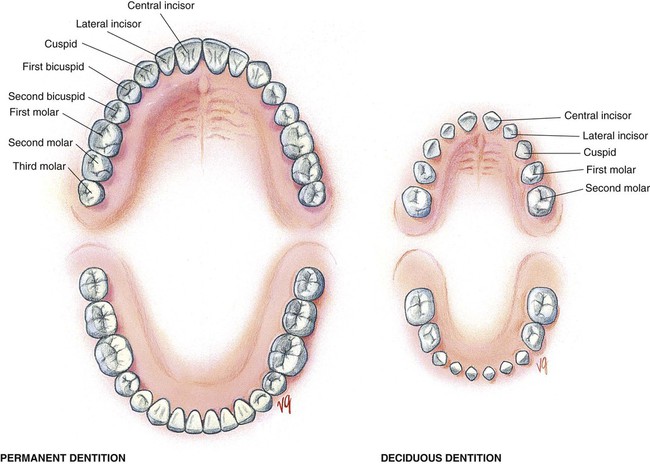
 The crown is the white section above the gum.
The crown is the white section above the gum.
 Enamel, the hardest substance in the body, covers the crown.
Enamel, the hardest substance in the body, covers the crown.
 Cementum is the hard, bonelike substance covering the root.
Cementum is the hard, bonelike substance covering the root.
 Dentin is located between the enamel and the pulp.
Dentin is located between the enamel and the pulp.
 The pulp is the soft living portion of the tooth, containing the nerves and blood vessels.
The pulp is the soft living portion of the tooth, containing the nerves and blood vessels.
Type of Tooth
Number
Function
Location
Description
Incisor
8
Cuts food
Front of mouth (central or lateral)
Broad, sharp edge
Cuspid (canines or eyeteeth)
4
Tears food
At angles of lips
Longest in mouth
Bicuspid (premolar)
8
Pulverizes or grinds food
Between cuspids and molars
Flat
Molar
12*
Grinds food
Back of mouth
Largest, strongest ![]()
Stay updated, free articles. Join our Telegram channel

Full access? Get Clinical Tree


Skeletal System
Get Clinical Tree app for offline access


